The State of The Rivers/Oceans/Water/Air
- Richprins
- Committee Member
- Posts: 76096
- Joined: Sat May 19, 2012 3:52 pm
- Location: NELSPRUIT
- Contact:
Re: The State of The Rivers/Oceans/Water
It is in a large part of our population's culture to litter. 
Please check Needs Attention pre-booking: https://africawild-forum.com/viewtopic.php?f=322&t=596
- Lisbeth
- Site Admin
- Posts: 67571
- Joined: Sat May 19, 2012 12:31 pm
- Country: Switzerland
- Location: Lugano
- Contact:
Re: The State of The Rivers/Oceans/Water
Like in India 
"Education is the most powerful weapon which you can use to change the world." Nelson Mandela
The desire for equality must never exceed the demands of knowledge
The desire for equality must never exceed the demands of knowledge
- nan
- Posts: 26322
- Joined: Thu May 31, 2012 9:41 pm
- Country: Switzerland
- Location: Central Europe
- Contact:
Re: The State of The Rivers/Oceans/Water
not only.... all Asia, South America and Africa... everywhere that there is poor people
we can't compare our rich countries, where is a scourge because we should all to be well educated
we can't compare our rich countries, where is a scourge because we should all to be well educated
Kgalagadi lover… for ever
https://safrounet.piwigo.com/
https://safrounet.piwigo.com/
- Richprins
- Committee Member
- Posts: 76096
- Joined: Sat May 19, 2012 3:52 pm
- Location: NELSPRUIT
- Contact:
Re: The State of The Rivers/Oceans/Water
I remember going to Zimbabwe and Namibia...they were clean! 
Please check Needs Attention pre-booking: https://africawild-forum.com/viewtopic.php?f=322&t=596
- Lisbeth
- Site Admin
- Posts: 67571
- Joined: Sat May 19, 2012 12:31 pm
- Country: Switzerland
- Location: Lugano
- Contact:
Re: The State of The Rivers/Oceans/Water
Also Botswana  and I think it's a bad habit like here in the middle age and before, because nobody collected it and they did not know better.
and I think it's a bad habit like here in the middle age and before, because nobody collected it and they did not know better.
"Education is the most powerful weapon which you can use to change the world." Nelson Mandela
The desire for equality must never exceed the demands of knowledge
The desire for equality must never exceed the demands of knowledge
- Lisbeth
- Site Admin
- Posts: 67571
- Joined: Sat May 19, 2012 12:31 pm
- Country: Switzerland
- Location: Lugano
- Contact:
Re: The State of The Rivers/Oceans/Water
POLLUTION ALERT
Maritime authority to probe Algoa Bay oil spill amid fears of threat to seabirds
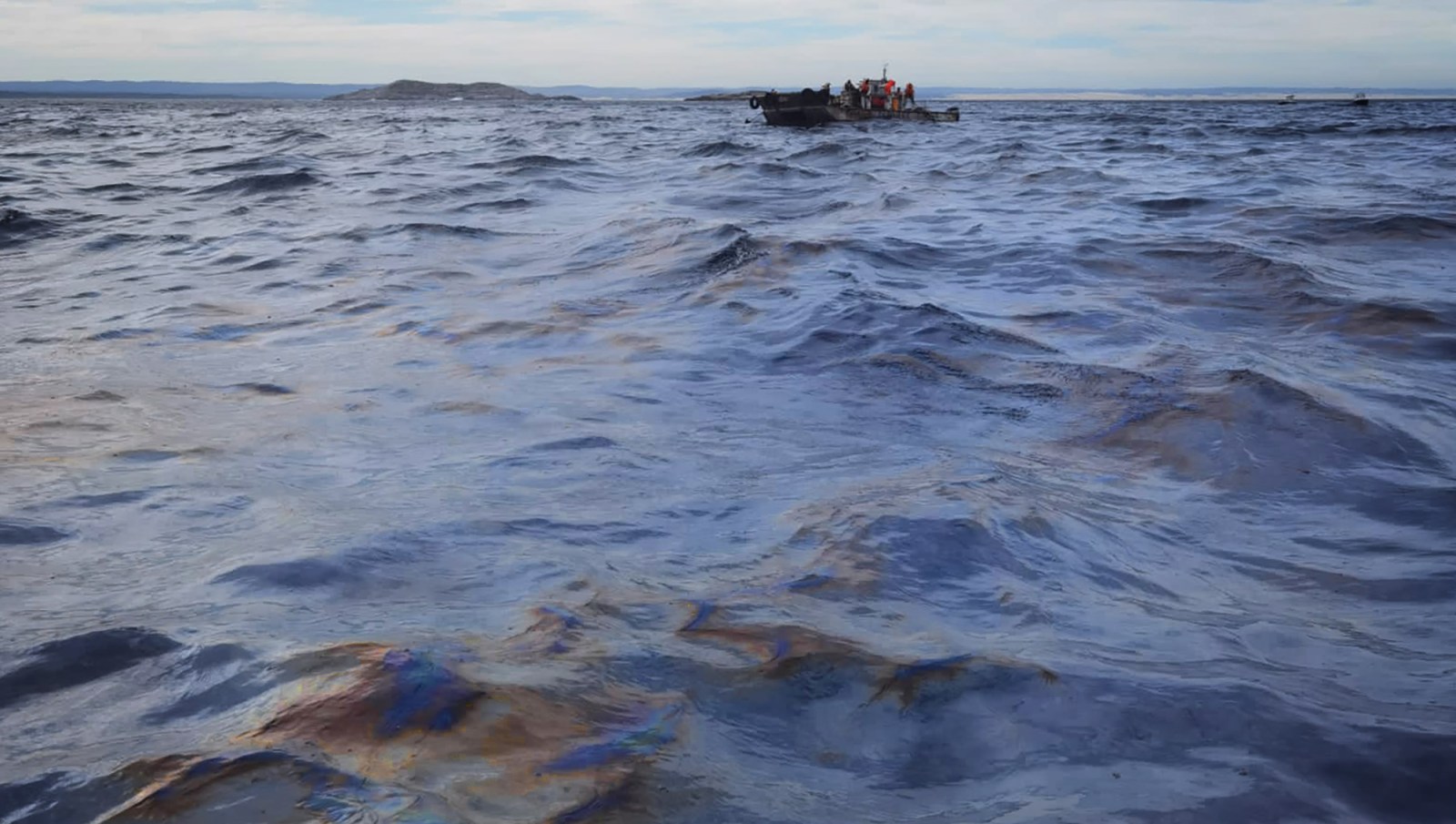
The South African Maritime Safety Authority cleans up after the oil spill in Algoa Bay on Monday, 23 May 2022. (Photo: Supplied)
By Tembile Sgqolana | 27 May 2022
A clean-up is under way in Algoa Bay after a ship-to-ship oil transfer went wrong on Monday.
___________________________________________________________________________________________________________
The South African Maritime Safety Authority (Samsa) is investigating the cause of the oil spill that occurred during a ship-to-ship transfer of oil at Algoa Bay on Monday.
Samsa activated all relevant pollution response units, booms were deployed to contain the oil around the vessels, and the authority has suspended bunkering operations in Algoa Bay.
Monica Stassen, the preparedness and response manager at the Southern African Foundation for the Conservation of Coastal Birds (Sanccob), said this was the fourth oil spill in the Algoa Bay region since 2016 when ship-to-ship bunkering was first permitted, with one involving the Croatian-flagged MV Solin just six months ago.
“So we are extremely concerned about the impact that this and any oil spill could have on the endangered species of seabirds,” he said.
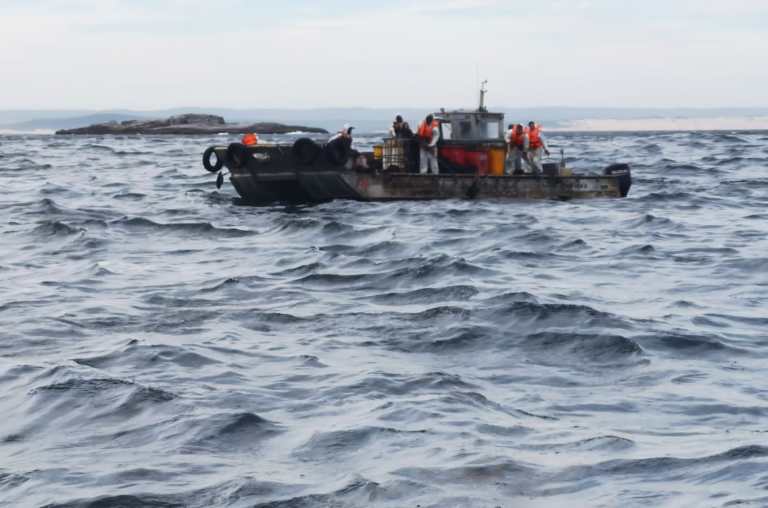
A clean-up is under way in Algoa Bay following the oil spill on Monday, 23 May 2022. (Photo: Supplied)
Sanccob was working closely with the relevant authorities regarding the spill in Algoa Bay, and no oiled seabirds had been reported yet.
“As part of our internal preparedness strategy, our response teams in Cape Town and Gqeberha are on standby in the event that we need to mobilise people and equipment, and Sanccob’s facility in Gqeberha is ready to receive birds,” she said.
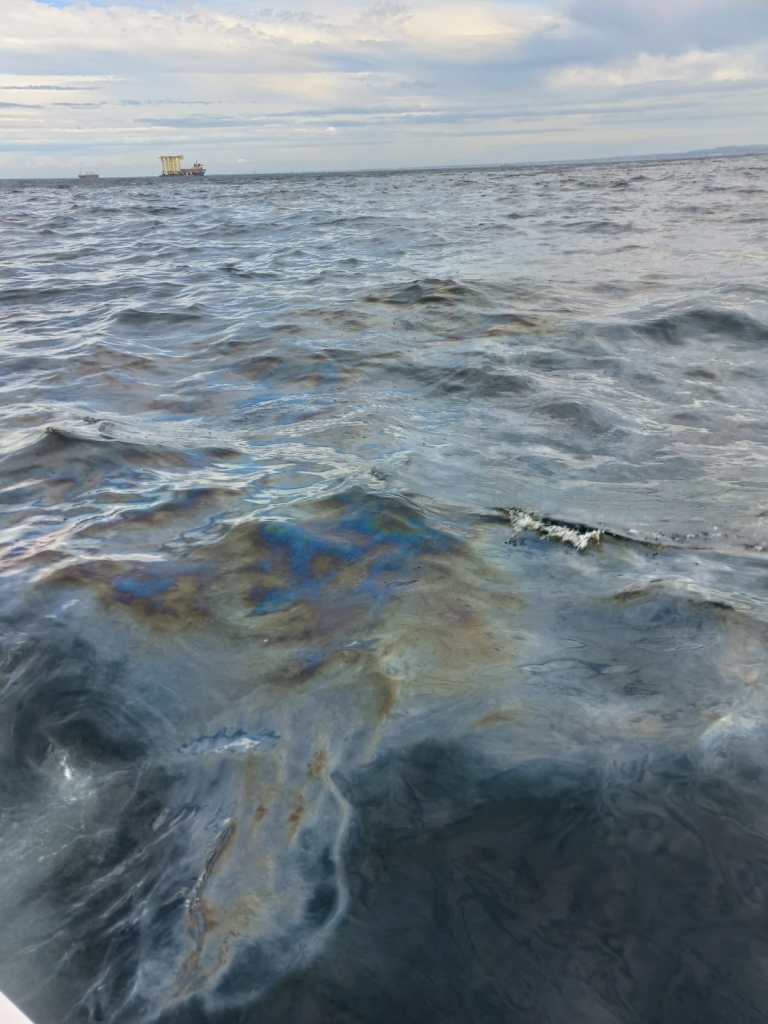
Oil in Algoa Bay following a ship-to-ship fuel bunkering incident on Monday, 23 May 2022. (Photo: Supplied)
Daily Maverick reported on 15 February 2020 that environmental organisations had opposed Samsa’s decision to lift the moratorium on new licences for ship-to-ship fuel bunkering in biodiversity hotspots in Algoa Bay from 1 April.
The organisations say past oil spills have affected endangered African penguins and other threatened seabird species.
Wildlife and Environment Society of South Africa Algoa Bay branch chairperson Gary Koekemoer said most of the heavy oil spill is in the area between the two ships and, thankfully, contained within the booms.
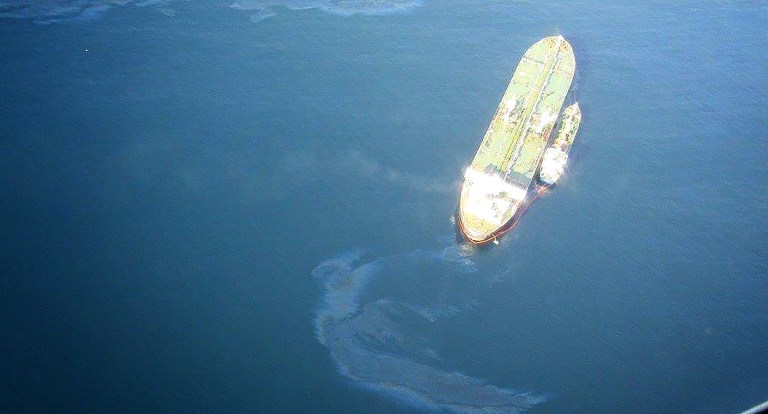
By Tuesday afternoon all the visible heavy oil had been collected while large patches of light oil sheen had been spotted in Algoa Bay, Samsa spokesperson Tebogo Ramatjie. (Photo: Supplied)
Koekemoer said it’s not just about cute penguins and dolphins, the whole ecosystem is affected and this ultimately affects small-scale fishers and the tourism industry.
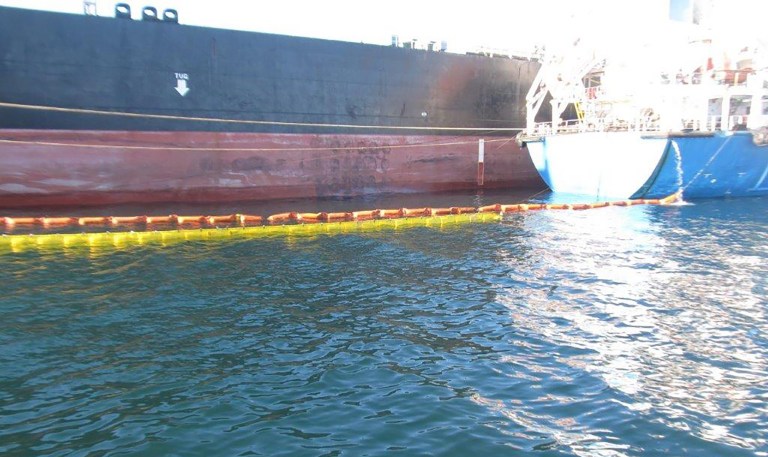
Samsa activated all relevant pollution response units, booms were deployed to contain the oil around the vessels, and the authority has suspended bunkering operations in Algoa Bay. (Photo: Supplied)
“The two vessels involved were separated yesterday (25 May) and the smaller vessel MT Lefkas has berthed at the Port of Port Elizabeth and all the oiled equipment has been removed from the water thus posing no pollution threat to the port and its operations. The motor tanker Umnenga II is not able to enter port yet due to the unavailability of a suitable berth,” said Samsa spokesperson Tebogo Ramatjie.
SANParks boat patrols had revealed no oil near the Algoa Bay islands and no oiled birds had been spotted.
“A fixed-wing aircraft with state-of-the-art oil-sensing equipment has been charted from Cape Town to conduct a full search for any oil over the entire Algoa Bay area. The aircraft will use high-definition cameras and oil-detection systems to complete a full aerial surveillance of the Algoa Bay area,” said Ramatjie.
If any oil was spotted, the aircraft would also complete live oil-spill modelling to determine the direction of the oil. However, the authorities were optimistic that most of the oil had been recovered and only the vessel hull cleaning needed to be completed.
He said the Environmental Protection Vessel and the Sarah Baartman are on standby in Algoa Bay to help with the clean-up.
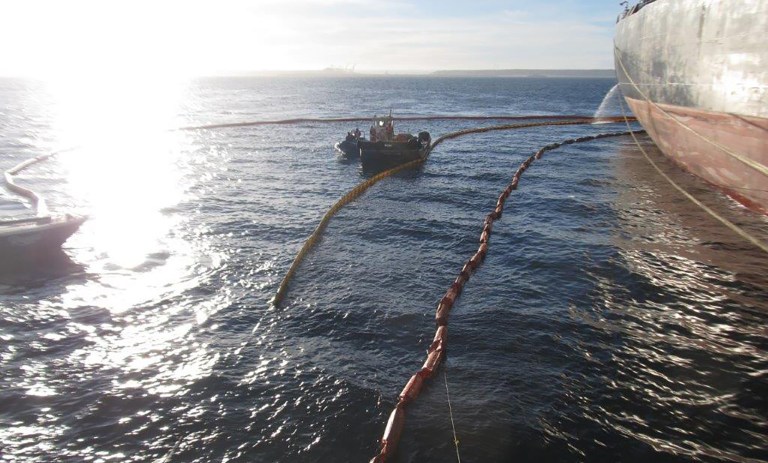
Five oil-recovery boats were being used to collect the oil. (Photo: Supplied)
In a statement on Wednesday, Ramatjie said five oil-recovery boats were being used to collect the oil and by Tuesday afternoon all the visible heavy oil had been collected while large patches of light oil sheen had been spotted in Algoa Bay.
“A helicopter was used for aerial surveillance and to assist in directing the boats towards the oil sheen for collection. However, due to rough sea conditions, the oil recovery was suspended by 3.35pm. The removal of the oiled ‘oil absorbent material’ between the two vessels continued throughout the night,” he said.
Oil spill modelling by the International Tanker Owners Pollution Federation indicated that the oil would not impact the Swartkops River or metro beaches, but would drift eastward towards the beaches of Woody Cape. DM/OBP
Maritime authority to probe Algoa Bay oil spill amid fears of threat to seabirds

The South African Maritime Safety Authority cleans up after the oil spill in Algoa Bay on Monday, 23 May 2022. (Photo: Supplied)
By Tembile Sgqolana | 27 May 2022
A clean-up is under way in Algoa Bay after a ship-to-ship oil transfer went wrong on Monday.
___________________________________________________________________________________________________________
The South African Maritime Safety Authority (Samsa) is investigating the cause of the oil spill that occurred during a ship-to-ship transfer of oil at Algoa Bay on Monday.
Samsa activated all relevant pollution response units, booms were deployed to contain the oil around the vessels, and the authority has suspended bunkering operations in Algoa Bay.
Monica Stassen, the preparedness and response manager at the Southern African Foundation for the Conservation of Coastal Birds (Sanccob), said this was the fourth oil spill in the Algoa Bay region since 2016 when ship-to-ship bunkering was first permitted, with one involving the Croatian-flagged MV Solin just six months ago.
“So we are extremely concerned about the impact that this and any oil spill could have on the endangered species of seabirds,” he said.

A clean-up is under way in Algoa Bay following the oil spill on Monday, 23 May 2022. (Photo: Supplied)
Sanccob was working closely with the relevant authorities regarding the spill in Algoa Bay, and no oiled seabirds had been reported yet.
“As part of our internal preparedness strategy, our response teams in Cape Town and Gqeberha are on standby in the event that we need to mobilise people and equipment, and Sanccob’s facility in Gqeberha is ready to receive birds,” she said.

Oil in Algoa Bay following a ship-to-ship fuel bunkering incident on Monday, 23 May 2022. (Photo: Supplied)
Daily Maverick reported on 15 February 2020 that environmental organisations had opposed Samsa’s decision to lift the moratorium on new licences for ship-to-ship fuel bunkering in biodiversity hotspots in Algoa Bay from 1 April.
The organisations say past oil spills have affected endangered African penguins and other threatened seabird species.
Wildlife and Environment Society of South Africa Algoa Bay branch chairperson Gary Koekemoer said most of the heavy oil spill is in the area between the two ships and, thankfully, contained within the booms.

By Tuesday afternoon all the visible heavy oil had been collected while large patches of light oil sheen had been spotted in Algoa Bay, Samsa spokesperson Tebogo Ramatjie. (Photo: Supplied)
- “A huge amount has passed, the estimates range from 1,000 litres to 3,000 litres, and is drifting with the southwesterly wind away from Gqeberha but into the marine protected area and close to the St Croix group of islands,” he said.
Koekemoer said it’s not just about cute penguins and dolphins, the whole ecosystem is affected and this ultimately affects small-scale fishers and the tourism industry.
- “We carry the risk and loss. The profits are reaped offshore,” he said.

Samsa activated all relevant pollution response units, booms were deployed to contain the oil around the vessels, and the authority has suspended bunkering operations in Algoa Bay. (Photo: Supplied)
“The two vessels involved were separated yesterday (25 May) and the smaller vessel MT Lefkas has berthed at the Port of Port Elizabeth and all the oiled equipment has been removed from the water thus posing no pollution threat to the port and its operations. The motor tanker Umnenga II is not able to enter port yet due to the unavailability of a suitable berth,” said Samsa spokesperson Tebogo Ramatjie.
SANParks boat patrols had revealed no oil near the Algoa Bay islands and no oiled birds had been spotted.
- “Members of the public are requested to report oiled birds and wildlife to SANParks or Sanccob Gqeberha at the Cape Recife Nature Reserve on 063 942 4702, but not to approach or try to capture the affected wildlife. Rangers will continue to monitor the islands for oiled birds returning from their feeding grounds in Algoa Bay,” he said.
“A fixed-wing aircraft with state-of-the-art oil-sensing equipment has been charted from Cape Town to conduct a full search for any oil over the entire Algoa Bay area. The aircraft will use high-definition cameras and oil-detection systems to complete a full aerial surveillance of the Algoa Bay area,” said Ramatjie.
If any oil was spotted, the aircraft would also complete live oil-spill modelling to determine the direction of the oil. However, the authorities were optimistic that most of the oil had been recovered and only the vessel hull cleaning needed to be completed.
He said the Environmental Protection Vessel and the Sarah Baartman are on standby in Algoa Bay to help with the clean-up.

Five oil-recovery boats were being used to collect the oil. (Photo: Supplied)
In a statement on Wednesday, Ramatjie said five oil-recovery boats were being used to collect the oil and by Tuesday afternoon all the visible heavy oil had been collected while large patches of light oil sheen had been spotted in Algoa Bay.
“A helicopter was used for aerial surveillance and to assist in directing the boats towards the oil sheen for collection. However, due to rough sea conditions, the oil recovery was suspended by 3.35pm. The removal of the oiled ‘oil absorbent material’ between the two vessels continued throughout the night,” he said.
Oil spill modelling by the International Tanker Owners Pollution Federation indicated that the oil would not impact the Swartkops River or metro beaches, but would drift eastward towards the beaches of Woody Cape. DM/OBP
"Education is the most powerful weapon which you can use to change the world." Nelson Mandela
The desire for equality must never exceed the demands of knowledge
The desire for equality must never exceed the demands of knowledge
- Lisbeth
- Site Admin
- Posts: 67571
- Joined: Sat May 19, 2012 12:31 pm
- Country: Switzerland
- Location: Lugano
- Contact:
Re: The State of The Rivers/Oceans/Water
Huge volume of plastic flood debris trapped inshore by Agulhas Current
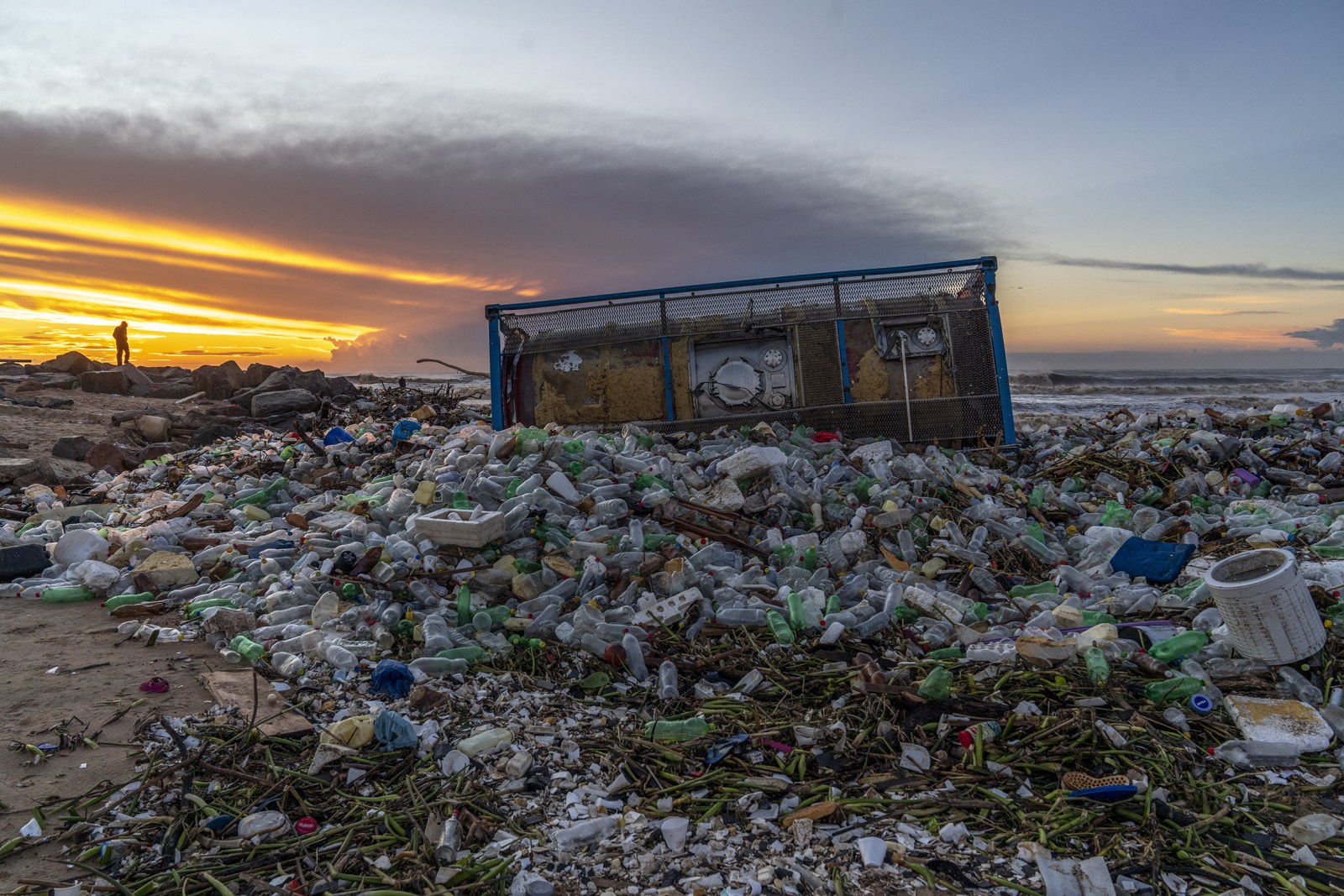
A stripped tanker and litter as seen strewn along a beach after floods wreaked havoc in Durban, KwaZulu-Natal. 13 April 2022. (Photo: Shiraaz Mohamed)
By Lorien Pichegru and Peter Ryan | 14 Jun 2022
During the Resilience oceanographic research cruise on the RV Marion Dufresne in early May 2022, we recorded the amounts and types of litter floating at sea off the east coast of South Africa. It was clear that the devastating April floods dumped huge amounts of litter into the sea.
_______________________________________________________________________________________________________
The April floods in KwaZulu-Natal resulted in the deaths of over 440 people and caused catastrophic damage to infrastructure, but one of the most visible impacts was the massive amounts of litter and other debris washed up along beaches in the area.
Over the Easter weekend alone, more than 40,000 bags of litter were collected from Durban’s beaches. For many years, poor solid waste management in many communities has resulted in large amounts of litter accumulating in river catchments around Durban.
And despite efforts to trap this litter in rivers (e.g. the LitterBoom Project), we have become accustomed to pictures of thousands of plastic bottles and other litter washing up on Durban beaches following rain events. It is thus not surprising that the devastating April floods dumped huge amounts of litter into the sea.
What is less well known is what happens to the litter once it enters the sea. Clearly, some of it quickly washes ashore. A recent study by researchers from the University of Cape Town’s FitzPatrick Institute of African Ornithology (Maclean et al, 2021, Marine Pollution Bulletin 173: 113078) showed that litter from Durban’s Mgeni River is transported north towards Mhlanga with the inshore counter-current.
At least 65% of marked litter items washed ashore, with buoyant items being more likely to be recovered on beaches than items closer to the density of seawater, such as flexible packaging (bags and wrappers). It is thus not surprising that drink bottles dominate the mountains of beach litter following the April flood.
During the Resilience oceanographic research cruise on the RV Marion Dufresne in early May 2022, we recorded the amounts and types of litter floating at sea off the east coast of South Africa.
There was no evidence of elevated litter levels in the Agulhas Current off northern KZN (0.2 items/km), but litter was abundant inshore of the current off Durban and south to the Pondoland coast. The presence of large amounts of terrestrial vegetation indicated that the litter was derived from land-based sources.
Much of the litter and vegetation was colonised by goose barnacles, so it had been at sea for a few weeks, consistent with it resulting from the April flood. This was confirmed by the very high proportion of items from South Africa, including one dairy tub lid with a “best before” date of 9 November 2010, which presumably had been trapped in a wetland for a decade.
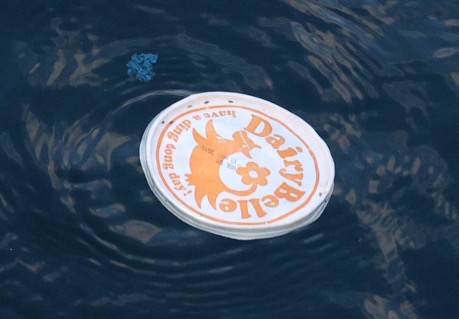
A South African dairy tub lid from 2010 shows that old litter items were released by the flood. (Photo: Peter Ryan)
The composition of the flood litter differed from that typically seen at sea off South Africa. Flexible packaging was much more frequent (70% of identifiable litter items) than is usually the case (20%), and bottles were unusually scarce (8%, compared to 27%). PET drink bottles were particularly rare, comprising only 0.5% of flood litter items, which contrasts strikingly with their dominance on beaches. This finding is similar to the experimental trials showing that most buoyant items wash ashore shortly after entering the sea.
Immediately east of Durban, the density of litter averaged close to 300 items/km inshore of the current, but abruptly decreased 50 km offshore, as we crossed into the Agulhas Current, where the density was 0.3 items/km. Repeated transects into the Agulhas Current farther south confirmed that the current acted as a barrier to offshore transport, trapping flood litter in coastal waters and transporting it mainly southward along the coast.
Incidentally, regular beach cleaners in the Algoa Bay area reported on social media that litter started washing up approximately four weeks after the flood. Once again, the presence of goose barnacles indicated that the litter had spent three to four weeks at sea. It is likely that the Durban flood litter will continue to be deposited along the east and south coast for weeks to come.
Our observations confirm the impact of flood events on marine litter, especially plastic items, which made up over 99% of all man-made litter items observed at sea. There is an urgent need for better waste management on land to avoid large amounts of plastic entering the sea as severe weather events such as the Durban floods become ever more frequent due to climate change. DM
Professor Peter Ryan is from the University of Cape Town’s FitzPatrick Institute of African Ornithology and Professor Lorien Pichegru is from Nelson Mandela University’s Institute for Coastal and Marine Research.

A stripped tanker and litter as seen strewn along a beach after floods wreaked havoc in Durban, KwaZulu-Natal. 13 April 2022. (Photo: Shiraaz Mohamed)
By Lorien Pichegru and Peter Ryan | 14 Jun 2022
During the Resilience oceanographic research cruise on the RV Marion Dufresne in early May 2022, we recorded the amounts and types of litter floating at sea off the east coast of South Africa. It was clear that the devastating April floods dumped huge amounts of litter into the sea.
_______________________________________________________________________________________________________
The April floods in KwaZulu-Natal resulted in the deaths of over 440 people and caused catastrophic damage to infrastructure, but one of the most visible impacts was the massive amounts of litter and other debris washed up along beaches in the area.
Over the Easter weekend alone, more than 40,000 bags of litter were collected from Durban’s beaches. For many years, poor solid waste management in many communities has resulted in large amounts of litter accumulating in river catchments around Durban.
And despite efforts to trap this litter in rivers (e.g. the LitterBoom Project), we have become accustomed to pictures of thousands of plastic bottles and other litter washing up on Durban beaches following rain events. It is thus not surprising that the devastating April floods dumped huge amounts of litter into the sea.
What is less well known is what happens to the litter once it enters the sea. Clearly, some of it quickly washes ashore. A recent study by researchers from the University of Cape Town’s FitzPatrick Institute of African Ornithology (Maclean et al, 2021, Marine Pollution Bulletin 173: 113078) showed that litter from Durban’s Mgeni River is transported north towards Mhlanga with the inshore counter-current.
At least 65% of marked litter items washed ashore, with buoyant items being more likely to be recovered on beaches than items closer to the density of seawater, such as flexible packaging (bags and wrappers). It is thus not surprising that drink bottles dominate the mountains of beach litter following the April flood.
During the Resilience oceanographic research cruise on the RV Marion Dufresne in early May 2022, we recorded the amounts and types of litter floating at sea off the east coast of South Africa.
There was no evidence of elevated litter levels in the Agulhas Current off northern KZN (0.2 items/km), but litter was abundant inshore of the current off Durban and south to the Pondoland coast. The presence of large amounts of terrestrial vegetation indicated that the litter was derived from land-based sources.
Much of the litter and vegetation was colonised by goose barnacles, so it had been at sea for a few weeks, consistent with it resulting from the April flood. This was confirmed by the very high proportion of items from South Africa, including one dairy tub lid with a “best before” date of 9 November 2010, which presumably had been trapped in a wetland for a decade.

A South African dairy tub lid from 2010 shows that old litter items were released by the flood. (Photo: Peter Ryan)
The composition of the flood litter differed from that typically seen at sea off South Africa. Flexible packaging was much more frequent (70% of identifiable litter items) than is usually the case (20%), and bottles were unusually scarce (8%, compared to 27%). PET drink bottles were particularly rare, comprising only 0.5% of flood litter items, which contrasts strikingly with their dominance on beaches. This finding is similar to the experimental trials showing that most buoyant items wash ashore shortly after entering the sea.
Immediately east of Durban, the density of litter averaged close to 300 items/km inshore of the current, but abruptly decreased 50 km offshore, as we crossed into the Agulhas Current, where the density was 0.3 items/km. Repeated transects into the Agulhas Current farther south confirmed that the current acted as a barrier to offshore transport, trapping flood litter in coastal waters and transporting it mainly southward along the coast.
Incidentally, regular beach cleaners in the Algoa Bay area reported on social media that litter started washing up approximately four weeks after the flood. Once again, the presence of goose barnacles indicated that the litter had spent three to four weeks at sea. It is likely that the Durban flood litter will continue to be deposited along the east and south coast for weeks to come.
Our observations confirm the impact of flood events on marine litter, especially plastic items, which made up over 99% of all man-made litter items observed at sea. There is an urgent need for better waste management on land to avoid large amounts of plastic entering the sea as severe weather events such as the Durban floods become ever more frequent due to climate change. DM
Professor Peter Ryan is from the University of Cape Town’s FitzPatrick Institute of African Ornithology and Professor Lorien Pichegru is from Nelson Mandela University’s Institute for Coastal and Marine Research.
"Education is the most powerful weapon which you can use to change the world." Nelson Mandela
The desire for equality must never exceed the demands of knowledge
The desire for equality must never exceed the demands of knowledge
- Richprins
- Committee Member
- Posts: 76096
- Joined: Sat May 19, 2012 3:52 pm
- Location: NELSPRUIT
- Contact:
Re: The State of The Rivers/Oceans/Water
People are pigs! 
Please check Needs Attention pre-booking: https://africawild-forum.com/viewtopic.php?f=322&t=596
- Lisbeth
- Site Admin
- Posts: 67571
- Joined: Sat May 19, 2012 12:31 pm
- Country: Switzerland
- Location: Lugano
- Contact:
Re: The State of The Rivers/Oceans/Water
A lot of people are ignorant pigs, but not all 
"Education is the most powerful weapon which you can use to change the world." Nelson Mandela
The desire for equality must never exceed the demands of knowledge
The desire for equality must never exceed the demands of knowledge
- Lisbeth
- Site Admin
- Posts: 67571
- Joined: Sat May 19, 2012 12:31 pm
- Country: Switzerland
- Location: Lugano
- Contact:
Re: The State of The Rivers/Oceans/Water
‘A tsunami of human waste’ – Half of SA’s sewage treatment works are failing, says report
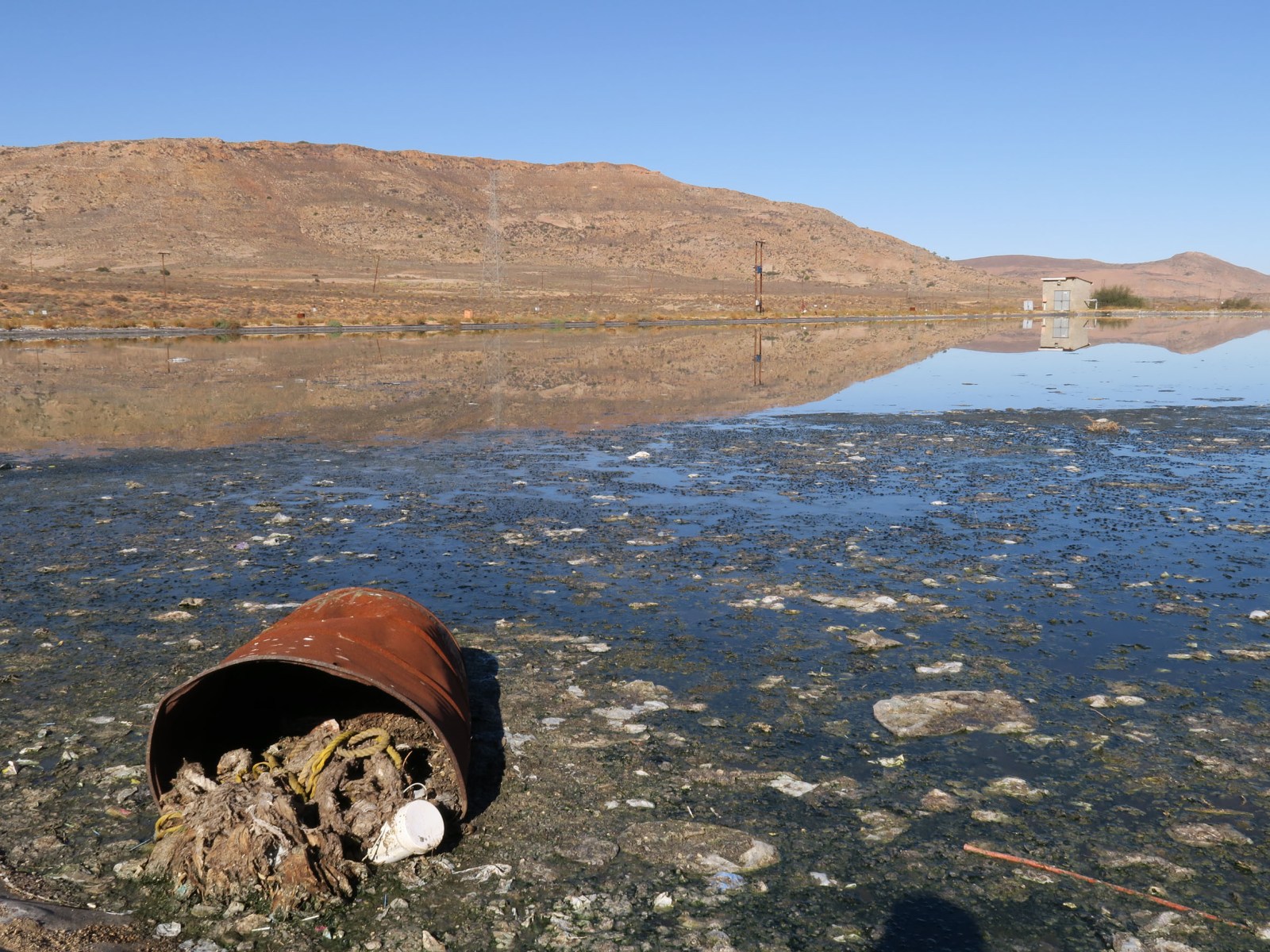
This is the failing sewage works in Springbok, Northern Cape, one of 334 in the country which obtained a Green Drop score of 30% or less. (Photo: Steve Kretzmann)
By Steve Kretzmann | 21 Jun 2022
The 2022 Green Drop report reveals scale of pollution in South Africa but also clouds the picture.
___________________________________________________________________________-_________________________________________________
After a nine-year hiatus, the long-awaited Green Drop report paints a bleak picture: half of wastewater treatment works in South Africa fail to treat sewage properly and in many cases fail to treat it at all.
Anthony Turton from the Centre for Environmental Management at the University of the Free State says this represents “a tsunami of human waste inundating our rivers and dams, without respite, for more than a decade”.
The number of critical treatment works listed in the last report in 2013, was 248. The latest Green Drop report, released on 30 March 2022, reveals wastewater compliance has plummeted in the intervening years. Of 850 municipal wastewater treatment works, 334 (39%) are in a critical state, obtaining a score of 30% or less.
“This decline is at both the treatment and sewer collection levels,” states the report. It is not just that wastewater treatment works are failing to properly treat sewage before releasing it back into the environment, much of it is spilling into the environment before even getting to the treatment works.
The average Green Drop score across all provinces was 50%, indicating that about half our raw sewage and industrial waste is not being treated to standards which are already inadequate, according to scientists in the fields of chemistry and epidemiology. The average score in 2013 was 61%.
The Green Drop score drop
But analysis of the Department of Water and Sanitation’s (DWS) own data shows that even some of the few wastewater treatment works which received scores of 90% or more, are polluting the environment.
Key to understanding this is the acronym NMR, which stands for No Monitoring Required. It is not reflected in the national Green Drop report, but is found in the individual provincial reports.
Green Drop scores for wastewater treatment works and the sewerage infrastructure servicing them are obtained using an equation in which weightings are given to five key performance areas: capacity management; environmental management; financial management; technical management; and effluent and sludge compliance, which, at 30%, has the highest weighting.
The report notes: “The effluent quality must comply to 90% (in total) with the authorised limits for the respective categories.”
There are three effluent quality indicators: microbiological compliance, indicating the concentration of faecal bacteria such as E.coli and enterococcus in the water; chemical compliance, indicating the concentration of chemicals such as nitrates and phosphates which negatively impact ecosystems; and physical compliance, indicating turbidity, electrical conductivity, and oxygen demand. The minimum compliance levels are set out in the wastewater treatment works’ authorisation issued by the DWS.
No Monitoring Required means a wastewater treatment works is exempt, according to its authorisation, from having to comply with all or some of these effluent quality indicators.
Five of the 22 Green Drop award winners fall into this category. All of these are in the Western Cape, which obtained 12 Green Drop awards.
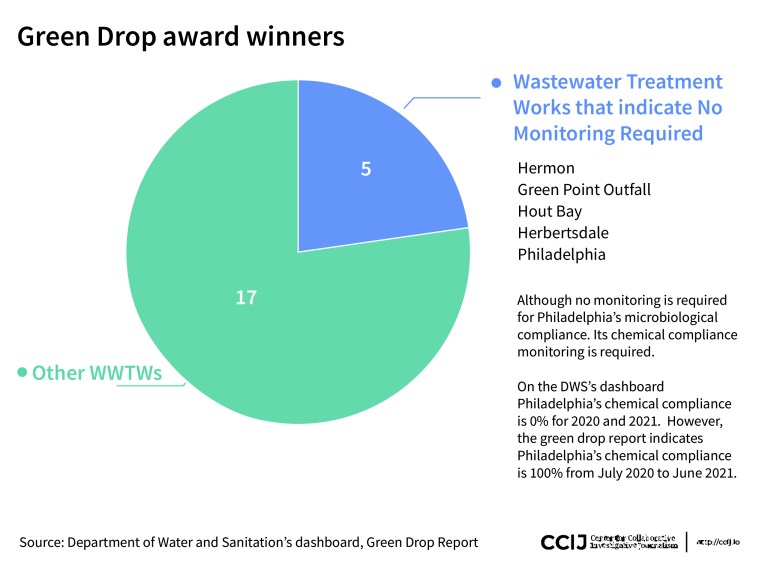
Green Drop award winners. (Graphic: Yuxi Wang, Center for Collaborative Investigative Journalism)
The Green Point and Hout Bay wastewater treatment works in the City of Cape Town are both Green Drop award winners. They are also marine outfalls. The only treatment the sewage receives before being pumped into the ocean is maceration through a 3mm sieve to remove solids and grit. The Green Point waste contains pharmaceutical and light industrial wastewater.
Neither of these facilities are required to monitor or reduce the faecal bacteria in the wastewater before releasing millions of litres of sewage into the ocean per day.
Following research conducted by Edda Weimann in 2013 that found Clifton beach contaminated with faecal bacteria, media reports and a public outcry over the marine outfalls led to the City commissioning its own report.
Conducted by the Council for Scientific and Industrial Research (CSIR) in 2017, it found “no immediate ecological disaster” was imminent as a result of effluent discharge from Cape Town’s marine outfalls.
But the report stated that there was “indirect evidence from faecal indicator bacteria counts in seawater samples collected at many sites along the Cape Town shoreline over an extended period that effluent is possibly, even if infrequently, reaching the shoreline”.
The CSIR report noted that although sewage outfalls are common in coastal cities around the world, “the world cannot use the marine environment as a waste receptacle in perpetuity and opportunities for improved and economically and environmentally feasible wastewater treatment, and the feasibility of using alternate strategies for disposing of wastewater to the marine environment should be investigated by the City of Cape Town (and other municipalities)”.
The City has stated it has no plans to divert wastewater disposed via the marine outfalls to wastewater treatment works.
Research in 2017 led by Professor Leslie Petrik of the University of the Western Cape Chemistry Department to determine whether sewage pollution was affecting seawater and marine organisms found E. coli counts near the outfalls that were thousands of times above the general limit for treated wastewater effluent.
Besides bacteria such as E. coli, and the nitrates and phosphates which are supposed to be removed during wastewater treatment, Petrik and her colleagues said that the sewage contains chemicals of emerging concern that current wastewater treatment methods, when applied, do not remove.
There are thousands of these synthetic chemicals used in pharmaceuticals, personal hygiene products, pesticides and industrial applications. These are stable compounds which do not break down in the environment, but accumulate.
Petrik and her colleagues tested for 15 of them in the area surrounding the Green Point marine outfall. They included diclofenac (an anti-inflammatory drug commonly known as Voltaren), sulfamethoxazole (an antibiotic used for a variety of infections), phenytoin (a medication used to prevent seizures), carbamazepine (a medication for epilepsy and bipolar disorder), lamivudine (used to treat HIV and Hepatitis B), and paracetamol. These were all found to be present in wet sea sand, and accumulating in marine organisms such as seaweed, sea urchins, starfish, and limpets.
Further studies found some of these chemical compounds accumulating in fish in False Bay, on the Indian Ocean side of the city. False Bay receives effluent either directly or indirectly from seven wastewater treatment plants, none of which received Green Drop certification awards.
The largest plant, the Cape Flats wastewater treatment plant which releases effluent into False Bay, scored 0% for microbiological compliance in 2020 and 2021 from the DWS. For chemical compliance it scored an average of 37%. Yet, inexplicably, it achieved a Green Drop score of 85%.
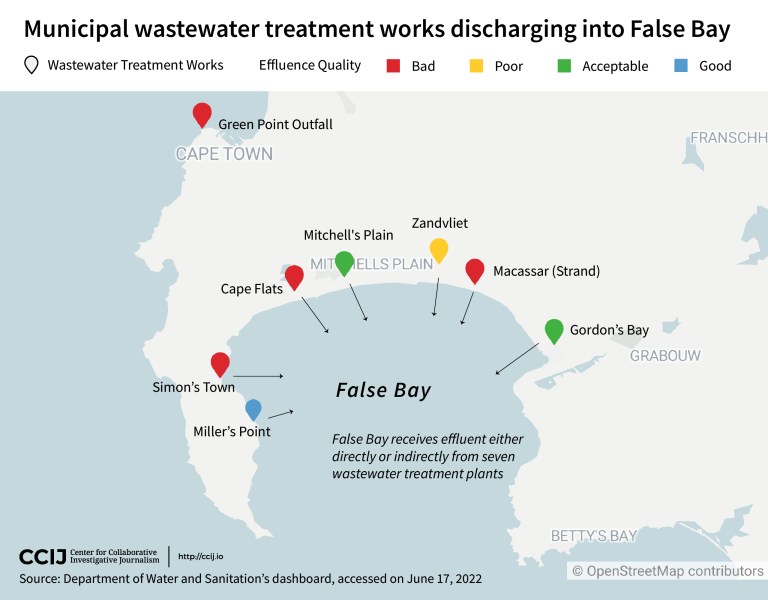
Municipal wastewater treatment works discharging into False Bay. (Graphic: Yuxi Wang, Center for Collaborative Investigative Journalism)
Further clouding the picture is the Green Drop report’s introduction of the contender awards. These are given to wastewater treatment works which fulfil all criteria but are disqualified from receiving a 90% score (the minimum for a certification award) because they fail to treat the effluent to minimum standards.
Contender status was awarded to 30 wastewater treatment works in the country, giving the impression their environmental impact is acceptable. However, eight of them failed dismally when it came to effluent quality, cumulatively releasing billions of litres of partially treated sewage into their catchments.
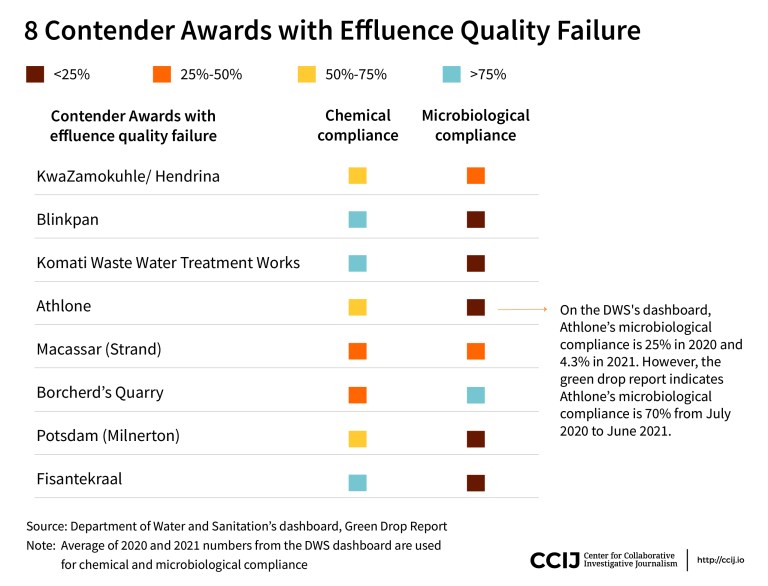
Eight contender awards with effluence quality failure. (Graphic: Yuxi Wang, Center for Collaborative Investigative Journalism)
Releasing approximately a million litres of effluent into the Diep River daily, Potsdam wastewater treatment works was given an 89% score in the Green Drop report, yet it only met minimum standards for effluent quality just 9% of the time during the year under review.
One of only six large estuaries on South Africa’s west coast, the Diep River estuary in Milnerton, Cape Town experienced a fish die-off in March.
Estuaries such as these are critically important as fish nurseries, says marine biologist and founder and director of Anchor Environmental Consultants Dr Barry Clark.
They are breeding grounds for a large number of species which are important for inshore fisheries, which are a source of livelihood for small-scale commercial and subsistence fishers, as well as recreational fishers who contribute to local economies.
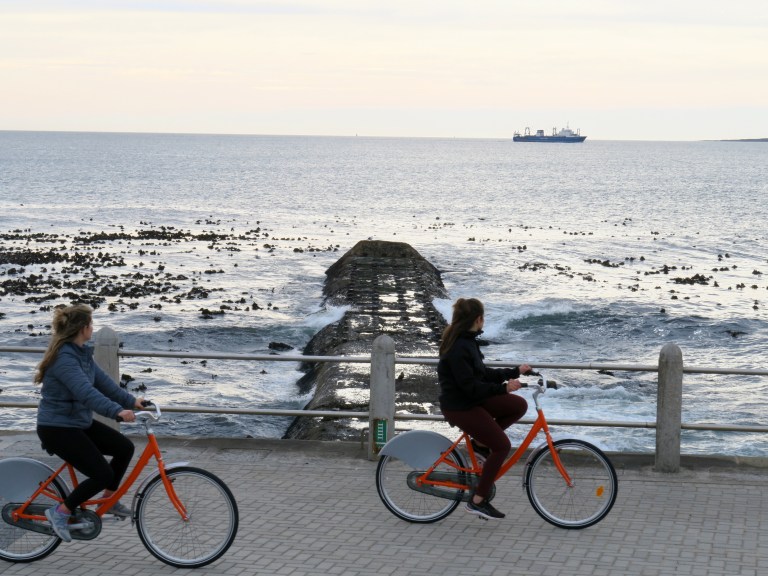
The Green Point marine outfall pipe, situated at Mouille Point, through which more than 20-million litres of raw sewage is pumped 1.7km out to sea every day. (Photo: Steve Kretzmann)
“On the west coast there are only five or six reasonably large estuaries, and the Diep River is one of them,” said Clark, with their scarcity making them “disproportionately important to fisheries”.
With Potsdam wastewater treatment works releasing huge volumes of wastewater into the Diep River estuary, it is in an “extremely poor state of health at the moment”.
He said the quality of wastewater flowing into the estuary has “deteriorated severely” over the last decade.
“Diep River estuary is hugely important and it’s a tragedy it’s effectively lost to society,” said Clark.
The City of Cape Town is making efforts to upgrade Potsdam wastewater treatment works and rehabilitate the Diep River estuary, but is falling short of meeting a directive meted out by the provincial Environmental Management Inspectorate in 2020.
Another of Cape Town’s high-scoring contender wastewater treatment works is Athlone, which releases effluent into the Black River, a major river running through the central city area. Athlone wastewater treatment works scored just 15% on average for microbiological compliance across 2020 and 2021 — the period of the latest Green Drop audit. Its chemical compliance levels were at 54% for the period.
Flowing through an industrial area, it is also polluted by high levels of heavy metals, as University of the Cape Town Masters student Lucy Gilbert found in 2015.
Yet the Black River remains a source of food and income for some Capetonians.
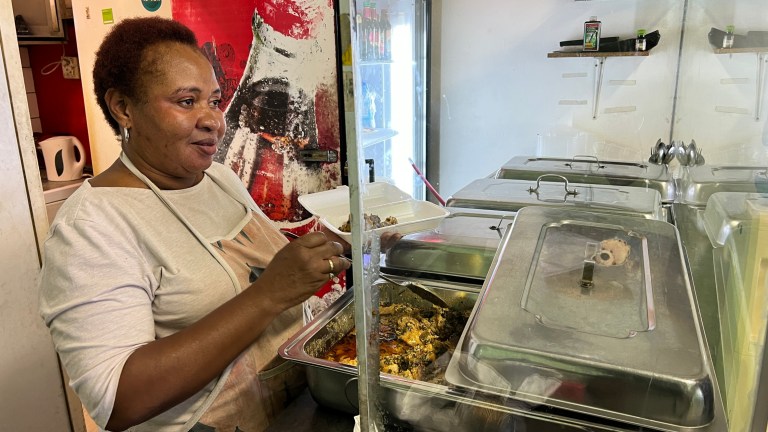
Abibat Lamidi buys catfish caught in the Black River to make a traditional pepper stew for her customers. She says the fish from the river smell like petrol, but the strong spices the dish calls for disguise this. (Photo: Peter Luhanga)
Abibat Lamidi runs a restaurant in the Maitland semi-industrial area near the Black River. Lamidi says she buys catfish caught in the Black River by informal fishers, paying between R30 to R50 a fish. She uses it as a base for a traditional pepper soup sought by her Nigerian customers.
But she says the taste of the Black River catfish is very different from catfish in Nigeria. “This catfish smells like petrol.” But she disguises the taste with the strong spices that make up the dish.
Given studies revealing bioaccumulation of chemical compounds up the food chain in the diluted seawaters along Cape Town’s coast, the long-term effect of consuming fish from the Black River, where pollutants are more concentrated, is of concern. DM
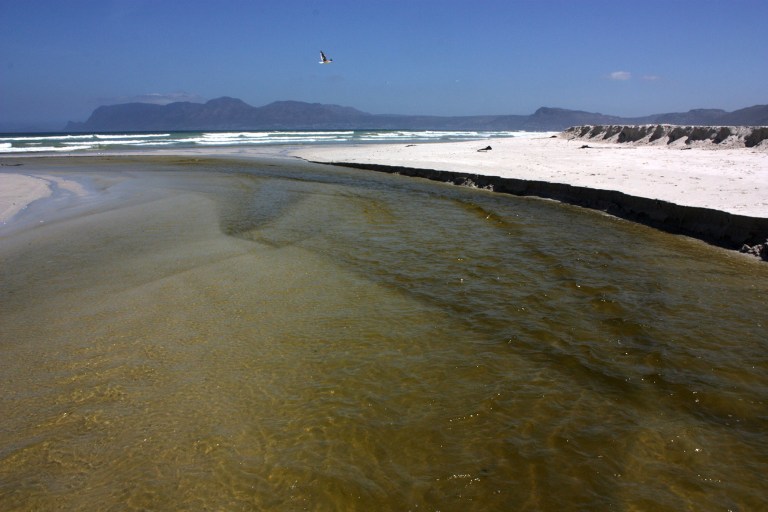
Polluted effluent flows from the Cape Flats Wastewater Treatment Works into False Bay at Strandfontein. According to Department of Water and Sanitation data, the Cape Flats treatment works scored 0% for microbiological compliance in 2020 and 2021. For chemical compliance, it complied with requirements just 37% of the time on average over the two years. (Photo: Steve Kretzmann)
This investigation was produced in collaboration with the Center for Collaborative Investigative Journalism and OpenUp, with the support of the Open Society Foundation.
First published by GroundUp.

This is the failing sewage works in Springbok, Northern Cape, one of 334 in the country which obtained a Green Drop score of 30% or less. (Photo: Steve Kretzmann)
By Steve Kretzmann | 21 Jun 2022
The 2022 Green Drop report reveals scale of pollution in South Africa but also clouds the picture.
___________________________________________________________________________-_________________________________________________
After a nine-year hiatus, the long-awaited Green Drop report paints a bleak picture: half of wastewater treatment works in South Africa fail to treat sewage properly and in many cases fail to treat it at all.
Anthony Turton from the Centre for Environmental Management at the University of the Free State says this represents “a tsunami of human waste inundating our rivers and dams, without respite, for more than a decade”.
The number of critical treatment works listed in the last report in 2013, was 248. The latest Green Drop report, released on 30 March 2022, reveals wastewater compliance has plummeted in the intervening years. Of 850 municipal wastewater treatment works, 334 (39%) are in a critical state, obtaining a score of 30% or less.
“This decline is at both the treatment and sewer collection levels,” states the report. It is not just that wastewater treatment works are failing to properly treat sewage before releasing it back into the environment, much of it is spilling into the environment before even getting to the treatment works.
The average Green Drop score across all provinces was 50%, indicating that about half our raw sewage and industrial waste is not being treated to standards which are already inadequate, according to scientists in the fields of chemistry and epidemiology. The average score in 2013 was 61%.
The Green Drop score drop
But analysis of the Department of Water and Sanitation’s (DWS) own data shows that even some of the few wastewater treatment works which received scores of 90% or more, are polluting the environment.
Key to understanding this is the acronym NMR, which stands for No Monitoring Required. It is not reflected in the national Green Drop report, but is found in the individual provincial reports.
Green Drop scores for wastewater treatment works and the sewerage infrastructure servicing them are obtained using an equation in which weightings are given to five key performance areas: capacity management; environmental management; financial management; technical management; and effluent and sludge compliance, which, at 30%, has the highest weighting.
The report notes: “The effluent quality must comply to 90% (in total) with the authorised limits for the respective categories.”
There are three effluent quality indicators: microbiological compliance, indicating the concentration of faecal bacteria such as E.coli and enterococcus in the water; chemical compliance, indicating the concentration of chemicals such as nitrates and phosphates which negatively impact ecosystems; and physical compliance, indicating turbidity, electrical conductivity, and oxygen demand. The minimum compliance levels are set out in the wastewater treatment works’ authorisation issued by the DWS.
No Monitoring Required means a wastewater treatment works is exempt, according to its authorisation, from having to comply with all or some of these effluent quality indicators.
Five of the 22 Green Drop award winners fall into this category. All of these are in the Western Cape, which obtained 12 Green Drop awards.

Green Drop award winners. (Graphic: Yuxi Wang, Center for Collaborative Investigative Journalism)
The Green Point and Hout Bay wastewater treatment works in the City of Cape Town are both Green Drop award winners. They are also marine outfalls. The only treatment the sewage receives before being pumped into the ocean is maceration through a 3mm sieve to remove solids and grit. The Green Point waste contains pharmaceutical and light industrial wastewater.
Neither of these facilities are required to monitor or reduce the faecal bacteria in the wastewater before releasing millions of litres of sewage into the ocean per day.
Following research conducted by Edda Weimann in 2013 that found Clifton beach contaminated with faecal bacteria, media reports and a public outcry over the marine outfalls led to the City commissioning its own report.
Conducted by the Council for Scientific and Industrial Research (CSIR) in 2017, it found “no immediate ecological disaster” was imminent as a result of effluent discharge from Cape Town’s marine outfalls.
But the report stated that there was “indirect evidence from faecal indicator bacteria counts in seawater samples collected at many sites along the Cape Town shoreline over an extended period that effluent is possibly, even if infrequently, reaching the shoreline”.
The CSIR report noted that although sewage outfalls are common in coastal cities around the world, “the world cannot use the marine environment as a waste receptacle in perpetuity and opportunities for improved and economically and environmentally feasible wastewater treatment, and the feasibility of using alternate strategies for disposing of wastewater to the marine environment should be investigated by the City of Cape Town (and other municipalities)”.
The City has stated it has no plans to divert wastewater disposed via the marine outfalls to wastewater treatment works.
Research in 2017 led by Professor Leslie Petrik of the University of the Western Cape Chemistry Department to determine whether sewage pollution was affecting seawater and marine organisms found E. coli counts near the outfalls that were thousands of times above the general limit for treated wastewater effluent.
Besides bacteria such as E. coli, and the nitrates and phosphates which are supposed to be removed during wastewater treatment, Petrik and her colleagues said that the sewage contains chemicals of emerging concern that current wastewater treatment methods, when applied, do not remove.
There are thousands of these synthetic chemicals used in pharmaceuticals, personal hygiene products, pesticides and industrial applications. These are stable compounds which do not break down in the environment, but accumulate.
Petrik and her colleagues tested for 15 of them in the area surrounding the Green Point marine outfall. They included diclofenac (an anti-inflammatory drug commonly known as Voltaren), sulfamethoxazole (an antibiotic used for a variety of infections), phenytoin (a medication used to prevent seizures), carbamazepine (a medication for epilepsy and bipolar disorder), lamivudine (used to treat HIV and Hepatitis B), and paracetamol. These were all found to be present in wet sea sand, and accumulating in marine organisms such as seaweed, sea urchins, starfish, and limpets.
Further studies found some of these chemical compounds accumulating in fish in False Bay, on the Indian Ocean side of the city. False Bay receives effluent either directly or indirectly from seven wastewater treatment plants, none of which received Green Drop certification awards.
The largest plant, the Cape Flats wastewater treatment plant which releases effluent into False Bay, scored 0% for microbiological compliance in 2020 and 2021 from the DWS. For chemical compliance it scored an average of 37%. Yet, inexplicably, it achieved a Green Drop score of 85%.

Municipal wastewater treatment works discharging into False Bay. (Graphic: Yuxi Wang, Center for Collaborative Investigative Journalism)
Further clouding the picture is the Green Drop report’s introduction of the contender awards. These are given to wastewater treatment works which fulfil all criteria but are disqualified from receiving a 90% score (the minimum for a certification award) because they fail to treat the effluent to minimum standards.
Contender status was awarded to 30 wastewater treatment works in the country, giving the impression their environmental impact is acceptable. However, eight of them failed dismally when it came to effluent quality, cumulatively releasing billions of litres of partially treated sewage into their catchments.

Eight contender awards with effluence quality failure. (Graphic: Yuxi Wang, Center for Collaborative Investigative Journalism)
Releasing approximately a million litres of effluent into the Diep River daily, Potsdam wastewater treatment works was given an 89% score in the Green Drop report, yet it only met minimum standards for effluent quality just 9% of the time during the year under review.
One of only six large estuaries on South Africa’s west coast, the Diep River estuary in Milnerton, Cape Town experienced a fish die-off in March.
Estuaries such as these are critically important as fish nurseries, says marine biologist and founder and director of Anchor Environmental Consultants Dr Barry Clark.
They are breeding grounds for a large number of species which are important for inshore fisheries, which are a source of livelihood for small-scale commercial and subsistence fishers, as well as recreational fishers who contribute to local economies.

The Green Point marine outfall pipe, situated at Mouille Point, through which more than 20-million litres of raw sewage is pumped 1.7km out to sea every day. (Photo: Steve Kretzmann)
“On the west coast there are only five or six reasonably large estuaries, and the Diep River is one of them,” said Clark, with their scarcity making them “disproportionately important to fisheries”.
With Potsdam wastewater treatment works releasing huge volumes of wastewater into the Diep River estuary, it is in an “extremely poor state of health at the moment”.
He said the quality of wastewater flowing into the estuary has “deteriorated severely” over the last decade.
“Diep River estuary is hugely important and it’s a tragedy it’s effectively lost to society,” said Clark.
The City of Cape Town is making efforts to upgrade Potsdam wastewater treatment works and rehabilitate the Diep River estuary, but is falling short of meeting a directive meted out by the provincial Environmental Management Inspectorate in 2020.
Another of Cape Town’s high-scoring contender wastewater treatment works is Athlone, which releases effluent into the Black River, a major river running through the central city area. Athlone wastewater treatment works scored just 15% on average for microbiological compliance across 2020 and 2021 — the period of the latest Green Drop audit. Its chemical compliance levels were at 54% for the period.
Flowing through an industrial area, it is also polluted by high levels of heavy metals, as University of the Cape Town Masters student Lucy Gilbert found in 2015.
Yet the Black River remains a source of food and income for some Capetonians.

Abibat Lamidi buys catfish caught in the Black River to make a traditional pepper stew for her customers. She says the fish from the river smell like petrol, but the strong spices the dish calls for disguise this. (Photo: Peter Luhanga)
Abibat Lamidi runs a restaurant in the Maitland semi-industrial area near the Black River. Lamidi says she buys catfish caught in the Black River by informal fishers, paying between R30 to R50 a fish. She uses it as a base for a traditional pepper soup sought by her Nigerian customers.
But she says the taste of the Black River catfish is very different from catfish in Nigeria. “This catfish smells like petrol.” But she disguises the taste with the strong spices that make up the dish.
Given studies revealing bioaccumulation of chemical compounds up the food chain in the diluted seawaters along Cape Town’s coast, the long-term effect of consuming fish from the Black River, where pollutants are more concentrated, is of concern. DM

Polluted effluent flows from the Cape Flats Wastewater Treatment Works into False Bay at Strandfontein. According to Department of Water and Sanitation data, the Cape Flats treatment works scored 0% for microbiological compliance in 2020 and 2021. For chemical compliance, it complied with requirements just 37% of the time on average over the two years. (Photo: Steve Kretzmann)
This investigation was produced in collaboration with the Center for Collaborative Investigative Journalism and OpenUp, with the support of the Open Society Foundation.
First published by GroundUp.
"Education is the most powerful weapon which you can use to change the world." Nelson Mandela
The desire for equality must never exceed the demands of knowledge
The desire for equality must never exceed the demands of knowledge


